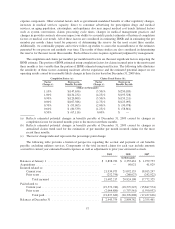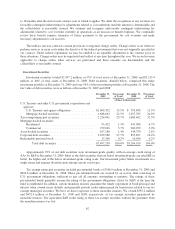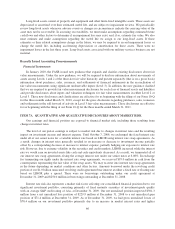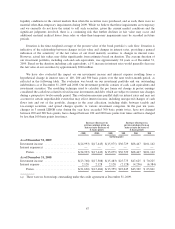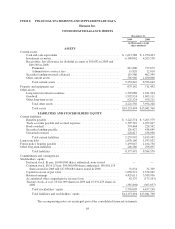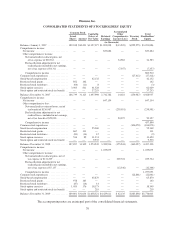Humana 2009 Annual Report Download - page 76
Download and view the complete annual report
Please find page 76 of the 2009 Humana annual report below. You can navigate through the pages in the report by either clicking on the pages listed below, or by using the keyword search tool below to find specific information within the annual report.Long-lived assets consist of property and equipment and other finite-lived intangible assets. These assets are
depreciated or amortized over their estimated useful life, and are subject to impairment reviews. We periodically
review long-lived assets whenever adverse events or changes in circumstances indicate the carrying value of the
asset may not be recoverable. In assessing recoverability, we must make assumptions regarding estimated future
cash flows and other factors to determine if an impairment loss may exist, and, if so, estimate fair value. We also
must estimate and make assumptions regarding the useful life we assign to our long-lived assets. If these
estimates or their related assumptions change in the future, we may be required to record impairment losses or
change the useful life, including accelerating depreciation or amortization for these assets. There were no
impairment losses in the last three years. Long-lived assets associated with our military services business are not
material.
Recently Issued Accounting Pronouncements
Financial Instruments
In January 2010, the FASB issued new guidance that expands and clarifies existing disclosures about fair
value measurements. Under the new guidance, we will be required to disclose information about movements of
assets among Levels 1 and 2 of the three-tier fair value hierarchy and present separately (that is on a gross basis)
information about purchases, sales, issuances, and settlements of financial instruments in the reconciliation of
fair value measurements using significant unobservable inputs (Level 3). In addition, the new guidance clarified
that we are required to provide fair value measurement disclosures for each class of financial assets and liabilities
and provide disclosures about inputs and valuation techniques for fair value measurements in either Level 2 or
Level 3. These new disclosures and clarifications are effective for us beginning with the filing of our Form 10-Q
for the three months ended March 31, 2010, except for the gross disclosures regarding purchases, sales, issuances
and settlements in the roll forward of activity in Level 3 fair value measurements. Those disclosures are effective
for us beginning with the filing of our Form 10-Q for the three months ended March 31, 2011.
ITEM 7A. QUANTITATIVE AND QUALITATIVE DISCLOSURES ABOUT MARKET RISK
Our earnings and financial position are exposed to financial market risk, including those resulting from
changes in interest rates.
The level of our pretax earnings is subject to market risk due to changes in interest rates and the resulting
impact on investment income and interest expense. Until October 7, 2008, we exchanged the fixed interest rate
under all of our senior notes for a variable interest rate based on LIBOR using interest rate swap agreements. As
a result, changes in interest rates generally resulted in an increase or decrease to investment income partially
offset by a corresponding decrease or increase to interest expense, partially hedging our exposure to interest rate
risk. However, due to extreme volatility in the securities and credit markets, LIBOR increased while the interest
rate we would earn on invested assets like cash and cash equivalents decreased. As a result, we terminated all of
our interest rate swap agreements, fixing the average interest rate under our senior notes at 6.08%. In exchange
for terminating our rights under the interest rate swap agreements, we received $93.0 million in cash from the
counterparties representing the fair value of the swap assets. We may re-enter into interest rate swap agreements
in the future depending on market conditions and other factors. Amounts borrowed under the revolving credit
portion of our $1.0 billion unsecured revolving credit agreement bear interest at either a fixed rate or floating rate
based on LIBOR plus a spread. There were no borrowings outstanding under our credit agreement at
December 31, 2009 and $250.0 million in borrowings outstanding at December 31, 2008.
Interest rate risk also represents a market risk factor affecting our consolidated financial position due to our
significant investment portfolio, consisting primarily of fixed maturity securities of investment-grade quality
with an average S&P credit rating of AA+ at December 31, 2009. Our net unrealized position improved $301.3
million from a net unrealized loss position of $229.9 million at December 31, 2008 to a net unrealized gain
position of $71.4 million at December 31, 2009. As of December 31, 2009, we had gross unrealized losses of
$78.4 million on our investment portfolio primarily due to an increase in market interest rates and tighter
66



